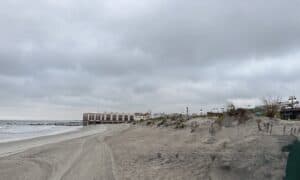Ocean City Braces for Potential Impact from Hurricane Erin
Hurricane Erin is not expected to make a direct landfall; its immense size and powerful swell are anticipated to have a significant effect on the East Coast. The primary concern is not wind or rain, but the potential for beach erosion as large ocean swells coincide with a new moon high tide.
According to the National Hurricane Center (NHC), Erin is currently a massive Category 4 hurricane with tropical-storm-force winds extending up to 230 miles from its center. Even from a distance, this wide wind field generates and pushes a tremendous amount of energy into the ocean, creating a long-period swell that is traveling all the way to the East Coast.
The peak of this swell is forecast to arrive in Ocean City on Thursday evening. (August 21st) The National Weather Service (NWS) predicts wave heights of 8 to 12 feet, with some forecasts calling for even larger surf.
This timing is particularly critical as it aligns with a new moon high tide. During a new moon, the sun and moon’s gravitational forces combine, resulting in higher-than-normal tides. A typical high tide in Ocean City ranges from about 3 to 5 feet; the tide on Thursday evening is predicted to reach approximately 4.6 feet. High tide is expected around 7:50 p.m.
When the large swells from Hurricane Erin combine with the higher water levels of the new moon high tide, there is a potential for increased coastal flooding and beach erosion.
While the situation requires attention and preparedness, it’s important to differentiate between a serious weather event and a direct-hit hurricane. This is a coastal event, not a direct hurricane hit. There will be no hurricane-force winds or torrential rain. The primary dangers are confined to the ocean, the immediate shoreline, and low-lying coastal areas.
Ocean City can anticipate dangerous surf, strong rip currents, and the potential for beach erosion. The public should be advised to exercise caution and heed all warnings from local authorities and the National Weather Service. This includes avoiding swimming in the ocean, staying off jetties and rock structures, and being aware of the potential for flooding in flood prone areas during high tide cycles.
